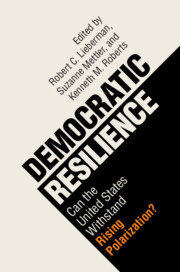Book contents
- Democratic Resilience
- Democratic Resilience
- Copyright page
- Dedication
- Contents
- Figures
- Tables
- Contributors
- Acknowledgments
- Part I Why Might Polarization Harm Democracy?
- Part II Political Institutions in Polarized Times
- Part III Social Polarization and Partisanship
- Part IV Vicious Circles? The Relationship between Polarized Behavior and Institutions
- 11 Polarization, the Administrative State, and Executive-Centered Partisanship
- 12 Laboratories of What?
- 13 Conservative Extra-Party Coalitions and Statehouse Democracy
- Part V Can Political Action Save Democracy in Polarized Times?
- Index
12 - Laboratories of What?
American Federalism and the Politics of Democratic Subversion
from Part IV - Vicious Circles? The Relationship between Polarized Behavior and Institutions
Published online by Cambridge University Press: 20 November 2021
- Democratic Resilience
- Democratic Resilience
- Copyright page
- Dedication
- Contents
- Figures
- Tables
- Contributors
- Acknowledgments
- Part I Why Might Polarization Harm Democracy?
- Part II Political Institutions in Polarized Times
- Part III Social Polarization and Partisanship
- Part IV Vicious Circles? The Relationship between Polarized Behavior and Institutions
- 11 Polarization, the Administrative State, and Executive-Centered Partisanship
- 12 Laboratories of What?
- 13 Conservative Extra-Party Coalitions and Statehouse Democracy
- Part V Can Political Action Save Democracy in Polarized Times?
- Index
Summary
The 2016 presidential election brought on a blizzard of foreboding announcements about American democracy. Yet as political scientists and pundits alike turned their gaze toward the spectacle of Trump’s Washington, fewer seemed as concerned about what was happening in places like Raleigh or Jefferson City. In fact, scholars and commentators troubled by abuses of power in the executive branch pointed to federalism as “the most effective tool” for protecting democracy, “especially if other constitutional checks fail.” States, it was argued, provided crucial venues for dissent and the formation of alternative governing coalitions. And while new analyses of democratic backsliding mentioned gerrymandering in state legislatures and state-level episodes of “constitutional hardball,” they tended to focus their attention on the national level.
Keywords
- Type
- Chapter
- Information
- Democratic ResilienceCan the United States Withstand Rising Polarization?, pp. 297 - 319Publisher: Cambridge University PressPrint publication year: 2021
- 9
- Cited by

